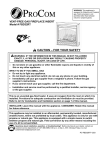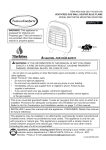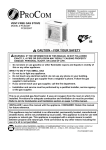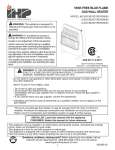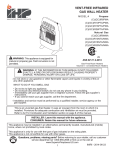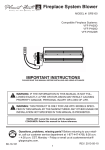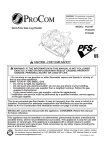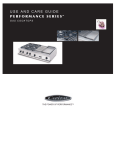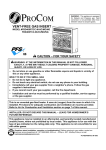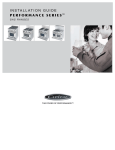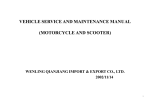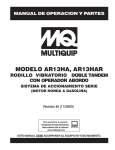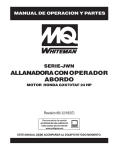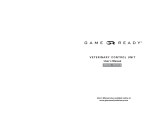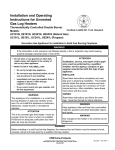Download Pleasant Hearth VFF-PH26D-T Instructions / Assembly
Transcript
VENT-FREE GAS DUAL FUEL FIREPLACE MODEL #VFF-PH(20D)(20D-C)(CPD-2T) VFF-PH(26D)(26D-T)(IMD-2H) VFF-PH(32DR)(32DR-H)(FSDR-2C) WARNING: This appliance is equipped for (Natural and Propane) gas. Field conversion is not permitted other than between natural or propane gases. NG LP Dual Fuel 418-S-06-5 CAUTION - FOR YOUR SAFETY ANSI Z21.11.2-2013 WARNING: IF THE INFORMATION IN THIS MANUAL IS NOT FOLLOWED EXACTLY, A FIRE OR EXPLOSION MAY RESULT CAUSING PROPERTY DAMAGE, PERSONAL INJURY OR LOSS OF LIFE. - Do not store or use gasoline or other flammable vapors and Iiquids in vicinity of this or any other appliance. WHAT TO DO IF YOU SMELL GAS • Do not try to light any appliance. • Do not touch any electrical switch; do not use any phone in your building. • Immediately call your gas supplier from a neighbor’s phone. Follow the gas supplier’s instructions. • If you cannot reach your gas supplier, call the fire department. - Installation and service must be performed by a qualified installer, service agency or the gas supplier. This is an unvented gas-fired heater. It uses air (oxygen) from the room in which it is installed. Provisions for adequate combustion and ventilation air most be provided. Refer to Air For Combustion and Ventilation section on page 8 of this manual. INSTALLER: Leave this manual with the appliance. CONSUMER: Retain this manual for future reference. This appliance may be installed in an aftermarket, permanently located manufactured (mobile) home, where not prohibited by local codes. This appliance is only for use with propane or natural gas. This appliance is equipped with a simple means to switch between propane and natural gas. Field conversion by any other means including the use of a kit is not permitted. Questions, problems, missing parts? Before returning to your retailer, call our customer service department at 1-877-447-4768, 8:30 a.m. –4:30 p.m., CST, Monday – Friday or email us at [email protected]. Rev. 2014-07-01 1 TABLE OF CONTENTS Specifications.................................................................................................................................... 2 Important Safety Information ............................................................................................................3 Product Identification......................................................................................................................... 5 Product Features............................................................................................................................... 6 Unpacking......................................................................................................................................... 6 Hood Assembly................................................................................................................................. 7 Preparing for Installation................................................................................................................... 8 Installation....................................................................................................................................... 11 Operation......................................................................................................................................... 23 Care and Maintenance.................................................................................................................... 26 Troubleshooting............................................................................................................................... 29 Replacement Parts.......................................................................................................................... 31 Accessories..................................................................................................................................... 32 Warranty.......................................................................................................................................... 34 WARNING: Read the Installation & Operating Instructions before using this appliance. IMPORTANT: Read all instructions and warnings carefully before starting installation. Failure to follow these instructions may result in possible injury to persons or a fire hazard and will void the warranty. Model Input Rating VFF-PH20/CP Series VFF-PH26/IM Series VFF-PH32/FS Series 20,000 BTU/Hr 27,500 BTU/Hr 32,000 BTU/Hr NG LP NG LP NG Gas TypeLP Manifold Pressure 10'' WC 4.5'' WC 10'' WC 4.5'' WC 10'' WC 4.5'' WC Max. Inlet Pressure 13'' WC 10'' WC 13'' WC 10'' WC 13'' WC 10'' WC Min. Inlet Pressure 8'' WC 3.5'' WC 8'' WC 3.5'' WC 8'' WC 3.5'' WC SERVICE HINTS When Gas Pressure Is Too Low • pilot will not stay lit • burners will have delayed ignition • fireplace will not produce specified heat • for propane/LP units, propane/LP gas supply may be low You may feel your gas pressure is too low. If so, contact your local natural or propane/LP gas supplier. 2 IMPORTANT SAFETY INFORMATION IMPORTANT: Read this owner’s manual carefully and completely before trying to assemble, operate, or service this heater. Improper use of this heater can cause serious injury or death from burns, fire, explosion, electrical shock, and carbon monoxide poisoning. Only a qualified installer, service agent, or local gas supplier may install and service this product. WARNING: Do not store or use gasoline or other flammable vapors or liquids in the vicinity of this or any other appliance. WARNING: This appliance can be used with propane or natural gas. It is shipped from the factory adjusted for use with propane. CARBON MONOXIDE POISONING: Early signs of carbon monoxide poisoning resemble the flu with headaches, dizziness, or nausea. If you have these signs, the heater may not be working properly. Get fresh air immediately! Have heater serviced. Some people are more affected by carbon monoxide than others. These include pregnant women, people with heart or lung disease, people who are anemic, those under the influence of alcohol, and those living in high altitudes. NATURAL AND PROPANE/LP GAS: Natural and Propane/LP gases are odorless. An odor-making agent is added to the gas. The odor helps you detect a gas leak. However, the odor added to the gas can fade. Gas may be present even though no odor exists. Make certain you read and understand all warnings. Keep this manual for reference. It is your guide to operating this heater safely. WARNING: Any change to this fireplace/heater or its controls can be dangerous. WARNING: Do not use any accessories not approved for use with this heater. WARNING: Carefully supervise young children when they are in the room with the heater. WARNING: Heater becomes very hot when operating. Keep children and adults away from hot surfaces to avoid burns or clothing ignition. Heater will remain hot for a time after shutoff. Allow surfaces to cool before touching. WARNING: Keep the appliance area clear and free from combustible materials, gasoline, and other flammable vapors and liquids. WARNING: Due to high temperatures, locate this appliance out of traffic and away from furniture and draperies. WARNING: Do not place clothing or other flammable material on or near the appliance. Never place any objects in the heater. CALIFORNIA PROPOSITION 65 Fuels used in gas or oil fired appliances and the products of combustion of such fuels contain chemicals known to the state of California to cause cancer, birth defects or other reproductive harm. This product contains chemicals, including lead and lead compounds, known to the state of California to cause cancer, birth defects or other reproductive harm. Wash hands after handling. 3 SAFETY INFORMATION 1. This appliance is only for use with the type of gas indicated on the rating plate. This appliance is not convertible for use with other gases. 2. Do not place propane/LP supply tank(s) inside any structure. Locate propane/LP supply tank(s) outdoors. 3. If you smell gas • shut off gas supply • do not try to light any appliance • do not touch any electrical switch; do not use any phone in your building • immediately call your gas supplier from a neighbor’s phone. Follow the gas supplier’s instructions • if you cannot reach your gas supplier, call the fire department 4. This fireplace shall not be installed in a bedroom or bathroom. 5. Do not use this fireplace as a wood-burning fireplace. Use only the logs provided with the fireplace. 6. Do not add extra logs or ornaments such as pine cones, vermiculite or rock wool. Using these added items can cause sooting. Do not add lava rock around base. Rock and debris could fall into the control area of fireplace. 7. This fireplace is designed to be smokeless. If logs ever appear to smoke, turn off fireplace and call a qualified service person. Note: During initial operation, slight smoking could occur due to log curing and fireplace burning manufacturing residues. 8. To prevent the creation of soot, follow the instructions in Cleaning and Maintenance, page 26. 9. Before using furniture polish, wax, carpet cleaner or similar products, turn fireplace off. If heated, the vapors from these products may create a white powder residue within burner box or on adjacent walls or furniture. 10. This fireplace needs fresh air ventilation to run properly. This fireplace has an Oxygen Depletion Sensing (ODS) safety shutoff system. The ODS shuts down the fireplace if not enough fresh air is available. See Air for Combustion and Ventilation, page 9. If fireplace keeps shutting off, see Troubleshooting, page 28. 11. Do not run fireplace • where flammable liquids or vapors are used or stored. • under dusty conditions. 12. Do not use this fireplace to cook food or burn paper or other objects. 13. Never place any objects in the fireplace or on logs. 14. Do not use fireplace if any part has been under water. Immediately call a qualified service technician to inspect the room fireplace and to replace any part of the control system and any gas control which has been under water. 15. Turn off and unplug fireplace and let cool before servicing. Only a qualified service person should service and repair fireplace. 16. Operating fireplace above elevations of 4,500 feet could cause pilot outage. 17. Do not operate fireplace if log is broken. Do not operate fireplace if log is chipped (dime-sized or larger). 18. To prevent performance problems, do not use propane/LP fuel tank of less than 100 lb. capacity. 19. Provide adequate clearances around air openings. QUALIFIED INSTALLING AGENCY Only a qualified agency should install and replace gas piping, gas utilization equipment or accessories, and repair and equipment servicing. The term "qualified agency" means any individual, firm, corporation, or company that either in person or through a representative is engaged in and is responsible for: a) Installing, testing, or replacing gas piping or b)Connecting, installing, testing, repairing, or servicing equipment; that is experienced in such work; that is familiar with all precautions required; and that has complied with all the requirements of the authority having jurisdiction. 4 PRODUCT IDENTIFICATION VFF-PH(26D)(26D-T)(IMD-2H)/ VFF-PH(20D)(20D-C)(CPD-2T) VFF-PH(32DR)(32DR-H)(FSDR-2C) Fireplace Cabinet Fireplace Cabinet Hood Hood Screen Screen Log Remote Transmitter Log Ignitor Button Ignitor Button Control Knob Control Knob EI Receiver Fig. 1 - Vent-Free Dual Fuel Fireplace Mantel Cabinet NOTE: The fireplace is installed into the mantel through the front opening of the mantel cabinet. WARNING: This fireplace is designed for use with the mantel cabinet provided. Installing the fireplace cabinet without the provided mantel or substituting another mantel will void the warranty and could resuly in property damage and personal injury. 5 PRODUCT FEATURES SAFETY PILOT This heater has a pilot with an Oxygen Depletion Sensing (ODS) safety shutoff system. The ODS/pilot shuts off the heater if there is not enough fresh air and cuts off main burner gas in the event of flame out. ELECTRIC PUSH BUTTON IGNITION SYSTEM This heater is equipped with an electronic piezo control system. This system requires one AAA battery batteries (provided). THERMOSTAT HEAT CONTROL The control automatically cycles the burner on and off to maintain a desired room temperature. See page 24. DUAL FUEL CAPABILITY Your heater is equipped to operate on either propane or natural gas. The heater is shipped from the factory ready for connecting to propane. The heater can easily be changed to natural gas by having your qualified installer follow the instructions on page 18 and the markings on the heater. BLOWER KIT (OPTIONAL) The blower kit helps to distribute the warmed air into the space more rapidly. State of Massachusetts: The installation must be made by a licensed plumber or gas fitter in the Commonwealth of Massachusetts. Sellers of unvented propane or natural gas-fired supplemental room heaters shall provide to each purchaser a copy of 527 CMR 30 upon sale of the unit. In the State of Massachusetts, unvented propane or natural gas-fired space heaters shall be prohibited in bedrooms and bathrooms. In the State of Massachusetts the gas cock must be a T-handle type. The State of Massachusetts requires that a flexible appliance connector cannot exceed three feet in length. LOCAL CODES Install and use heater with care. Follow all codes. In the absence of local codes, use the latest edition of The National Fuel Gas Code, ANSI Z223.1, also known as NFPA 54*. *Available from: American National Standard Institute, Inc. 1430 Broadway New York, NY 10018 National Fire Protection Association, Inc. 1 Batterymarch Park Quincy, MA 02269-9101 This heater is designed for vent-free operation. State and local codes in some areas prohibit the use of vent-free heaters. UNPACKING 1. Remove fireplace cabinet and hood from carton. Log is wrapped and inside fireplace. Do not remove at this time. 2. Remove all protective packaging applied to fireplace for shipment. 3. Make sure your fireplace includes one hardware packet. 4. Check fireplace for any shipping damage. If fireplace is damaged, call GHP Group, Inc., at 1-877447-4768. Please do not return it to the store. 6 HOOD ASSEMBLY (IF REQUIRED) WARNING: Always have screen in place before operating fireplace. This prevents excessive temperatures on fireplace surfaces. WARNING: Failure to position the parts in accordance with these diagrams or failure to use only parts specifically approved with this fireplace may result in property damage or personal injury. Tools Required: • Phillips screwdriver • scissors 1. If equipped, lift fireplace screen up and pull out to remove (See. Fig 2). Set screen aside until installation has been completed. Screen 2. Cut two plastic straps to remove log from firebox cavity. Set log aside. 3. An optional blower is available. See Accessories, page 36. Install optional blower now. Follow installation instructions provided with blower. 4. Locate four black Phillips sheet metal screws in hardware packet. 5. Slide hood between louver and firebox top and align screw holes. 6. Insert screws as shown in Figure 3. Tighten screws firmly. Shoulder Screw Fig. 2 - Removing and Installing Screen Louver Firebox Top Sheet Metal Screws Hood Fig. 3 - Assembling Hood (If Required) 7 PREPARING FOR INSTALLATION AIR FOR COMBUSTION AND VENTILATION WARNING: This heater shall not be installed in a room or space unless the required volume of indoor combustion air is provided by the method described in the Nation Fuel Gas Code, ANSI Z223.1/NFPA 54, the International Fuel Gas Code, or applicable local codes. PRODUCING ADEQUATE VENTILATION All spaces in homes fall into one of the three following ventilation classifications: 1. Unusually Tight Construction 2. Unconfined Space 3. Confined Space The information on pages 9 through 11 will help you classify your space and provide adequate ventilation. Confined and Unconfined Space A confined space as a space whose volume is less than 50 cu. ft. per 1,000 BTU/hr (4.8 m^3 per kw) of the aggregate input rating of all appliances installed in that space and an unconfining space as a space whose volume is not less than 50 cu. ft. per 1,000 BTU/hr (4.8 m^3 per kw) of the aggregate input rating of all appliances installed in that space. Rooms connecting directly with the space in which the appliances are installed*, through openings not furnished with doors, are considered a part of the unconfined space. This heater shall not be installed in a confined space or unusually tight construction unless provisions are provided for adequate combustion and ventilation air. * Adjoining rooms are connecting only if there are doorless passageways or ventilation grills between them. Unusually Tight Construction The air that leaks around doors and windows may provide enough fresh air for combustion and ventilation. However, in buildings of unusually tight construction, you must provide additional fresh air. Unusually tight construction is defined as construction where: a) walls and ceilings exposed to the outside atmosphere have a continuous water vapor retarder with a rating of one perm (6x10-11kg per pa-sec-m2) or less with openings gasketed or sealed and b) weather stripping has been added on windows that can be opened and on doors and c) caulking or sealants are applied to areas such as joints around window and door frames, between sole plates and floors, between wall-ceiling joints, between wall panels, at penetrations for plumbing, electrical, and gas lines, and at other openings. If your home meets all of the three criteria above, you must provide additional fresh air. See “Ventilation Air From Outdoors” (page 9). If your home does not meet all of the three criteria above, proceed to “Determining Fresh-Air Flow For Heater Location”. 8 PREPARING FOR INSTALLATION DETERMINING FRESH-AIR FLOW FOR HEATER LOCATION Determining if You Have a Confined or Unconfined Space Use this worksheet to determine if you have a confined or unconfined space. Space: Includes the room in which you will install heater plus any adjoining rooms with doorless passageways or ventilation grills between the rooms. 1. Determine the volume of the space Length × Width × Height = cu. ft. (volume of space) Example: Space size 20 ft. (length) × 16 ft.(width) × 8 ft. (ceiling height) = 2560 cu. ft. (volume of space) If additional ventilation to adjoining room is supplied with grills or openings, add the volume of these rooms to the total volume of the space. 2. Divide the space volume by 50 cu. ft. to determine the maximum BTU/hr the space can support. _______ (volume of space) ÷ 50 cu. ft.= (Maximum BTU/hr the space can support) Example: 2560 cu. ft. (volume of space) ÷ 50 cu. ft. = 51.2 or 51,200 (maximum BTU/hr the space can support) 3. Add the BTU/hr of all fuel burning appliances in the space. Vent-free heater _________ BTU/hr Gas water heater* ________BTU/hr Gas furnace _____________BTU/hr Vented gas heater ________BTU/hr Example: Gas heater logs __________BTU/hr Gas water heater 30,000 BTU/hr Other gas appliances*+ ____BTU/hr Vent-free heater + 26,000 BTU/hr Total = ____BTU/hr Total = 56,000 BTU/hr *Do not include direct-vent gas appliances. Direct-vent draws combustion air from the outdoors and vents to the outdoors. 4. Compare the maximum BTU/hr the space can support with the actual amount of BTU/hr used. _______ BTU/hr (maximum the space can support) _______ BTU/hr (actual amount of BTU/hr used). Example : 51,200 BTU/hr (maximum the space can support) 56,000 BTU/hr (actual amount of BTU/hr used) The space in the above example is a confined space because the actual BTU/hr used is more than the maximum BTU/hr the space can support. You must provide additional fresh air. Your options are as follows: a) Rework worksheet, adding the space of an adjoining room. If the extra space provides an unconfined space, remove door to adjoining room or add ventilation grills between rooms. See “Ventilation Air From Inside Building,” page 11. b) Vent room directly to the outdoors. See “Ventilation Air From Outdoors”, page 11. c) Install a lower BTU/hr heater if lower BTU/hr size makes room unconfined. If the actual BTU/hr used is less than the maximum BTU/hr the space can support, the space is an unconfined space. You will need no additional fresh air ventilation. 9 PREPARING FOR INSTALLATION Ventilation Air From Inside Building This fresh air would come from adjoining unconfined space. When ventilating to an adjoining unconfined space, you must provide two permanent openings: one within 12 in. of the wall connecting the two spaces (see options 1 and 2, Fig. 4). You can also remove door into adjoining room (see option 3, Fig. 4). Follow the National Fuel Gas Code NFPA 54/ANS Z223.1. Air for Combustion and Ventilation for required size of ventilation grills or ducts. Ventilation Air From Outdoors Provide extra fresh air by using ventilation grills or duct. You must provide two permanent openings: one within 12 in. of the ceiling and one within 12 in. of the floor. Connect these items directly to the outdoors or spaces open to the outdoors. These spaces include attics and crawl spaces. Follow the National Fuel Gas Code NFPA 54/ANS Z223.1. Air for Combustion and Ventilation for required size of ventilation grills or ducts. Fig. 4 - Ventilation Air from Inside Building IMPORTANT: Do not provide openings for inlet or outlet air into attic if attic has a thermostat-controlled power vent. Heated air entering the attic will activate the power vent. Rework worksheet, adding the space of the adjoining unconfined space. The combined spaces must have enough fresh air to supply all appliances in both spaces. Fig. 5 - Ventilation Air from Outdoors 10 INSTALLATION WARNING: Do not attempt to access or change the setting of the fuel selection means. Access to and adjustment of the fuel selection means must only be a performed by a qualified service person when connecting this appliance to a specified fuel supply at the time of installation. Change of the selector setting to other than the fuel type specified at the time of installation could damage this appliance and render it inoperable. The installer shall replace the access cover before completing the installation and operating this appliance. NOTICE: This heater is intended for use as supplemental heat. Use this heater along with your primary heating system. Do not install this heater as your primary heat source. If you have a central heating system, you may run system’s circulating blower while using heater. This will help circulate the heat throughout the house. WARNING: A qualified technician must install heater. Follow all local codes. WARNING: Never install the heater: • in a bedroom or bathroom • in a recreational vehicle • where curtains, furniture, clothing, or other flammable objects are less than 42 in. from the front, top or sides of the heater. • in high traffic areas • in windy or drafty areas WARNING: Maintain the minimum clearances. If possible, provide greater clearances from the floor, ceiling, and adjoining wall than required. CAUTION: This heater creates warm air currents. These currents move heat to wall surfaces next to heater. Installing heater next to vinyl or cloth wall coverings or operating heater where impurities (such as tobacco smoke, aromatic candles, cleaning fluids, oil or kerosene lamps, etc.) in the air exist, may cause walls to discolor. IMPORTANT: Vent-free heaters add moisture to the air. Although this is beneficial, installing heater in rooms without enough ventilation air may cause mildew to form from too much moisture. See Air for Combustion and Ventilation, pages 9 through 11. CHECK GAS TYPE Be sure your gas supply is right for your heater. CLEARANCES TO COMBUSTIBLES Carefully follow the instructions below. This heater is a wall mount unit designed to sit directly on the mantel base. IMPORTANT: Maintain the minimum clearances shown in Figure 6 on page 12. If you can, provide greater clearances from floor, ceiling and joining wall. 11 INSTALLATION FIREPLACE CLEARANCES CAUTION: If you install the fireplace in a home garage • fireplace pilot and burner must be at least 18" above floor. • locate fireplace where moving vehicle will not hit it. For convenience and efficiency, install fireplace • where there is easy access for operation, inspection and service • in coldest part of room • If this appliance is to be installed directly on carpeting, tile or other combsutible material, other than wood flooring, the appliance must be installed on a metal or wood panel extending the full width and depth of the appliance. An optional blower kit is available from your retailer. See Accessories, page 36. If planning to use blower, follow instructions provided with blower for power source. Minimum Clearances For Side Combustible Material, Side Wall and Ceiling A. Clearances from the side of the fireplace cabinet to any combustible material and wall should follow diagram in Figure 6. B. Clearances from the top of the fireplace opening to the ceiling should not be less than 36". Min. Min. 36'' 36’’ 6’’ 6'' Either Either Side Side 6'' 36'' Fig. 6 - Minimum Clearance to Combustible Material • This firebox is only for use with the mantel provided. 12 INSTALLATION WARNING: This appliance is equipped with a three-prong (grounding) plug for your protection against shock hazard and must be plugged directly into a properly grounded three-prong receptacle. Firebox must be disconnected from gas supply and removed from mantel before installing fan accessory. Contact a qualified service person to do this. BLOWER INSTALLATION (OPTIONAL) 1. Remove Blower Access Panel. 1 Access Panel 2. Mount Blower (B) onto bottom of Fireplace Top using 4 screws (F). 2 3. Attach Power Cord (A) to Blower Access Panel. 3 Screws Power Cord Access Panel 4a. Attach Temperature Sensor (C) to Sensor Bracket using 2 screws, 2 lock washers, and 2 nuts. 4 Screw FF 4b. Temperature Sensor Lock Washer Attach Sensor Bracket to the Combustion Top using 2 sheet metal screws. Nut Senser Bracket Combustion Top Mounting Holes 13 Sheet Metal Screws INSTALLATION 5. Important: Insert the wires marked with AUTO, OFF and MAN into line slot on the right corner. Keep wires close to the bottom. 5 6. Insert two wires’ female plugs marked with T1 and T2 (black and yellow) into two male ports on Temperature Sensor. 6 7. Insert the female plug on the white power supply wire (marked with P1), into the corresponding male port (marked with P1). 7 8. Insert the female plug (marked with P2) into the corresponding male port, which is on the black power supply wire (marked with P2). 8 14 INSTALLATION 9. Insert the blower link (male plug) into the power link (female port). 9 10. Important: Bind wires with cable ties (G), and attach cable ties (G) in holes on back of Outer Casing. Attach one in hole near the top and one in hole near the bottom. 10 G Fixed Hole 11. Insert AUTO, OFF, MAN wires through the Rocker Switch opening. 11 12. 12 Connect AUTO, OFF, MAN wires to the three corresponding male ports on the Rocker Switch (E). Match the "Auto" wire to the symbol " " and the "Man" wire to the symbol " " on the rocker switch (E). E 15 INSTALLATION 13. Push Rocker Switch (E) into Control Panel and secure.3 13 2 E 14. 14 Check that all wires are secure and reattach Blower Access Panel to Outer Casing. Capture the Green Ground wire between the Access Plate and Outer Casing with the upper right screw. Green Ground Wire Screw Access Panel Outer Casing Power Cord Electrical Wiring Diagram 2 WHITE ~120V 60Hz GREEN BLACK BLACK 1 5 1. Power Cord 2. Bushing Strain Relief 3. Blower 4. Temperature Sensor 5. Rocker Switch RED AUTO OFF MAN t FAN 4 3 NOTE: If any of the original wire as supplied with the appliance must be replaced, it must be replaced with a wire of at least an equal temperature rating. DRAWN dandowning 4/12/2013 CHECKED CAUTION: Label all wires prior to disconnection when servicing controls. Wiring errors can QA cause improper and dangerous operation. TITLE MFG Verify proper operation after servicing. APPROVED 16 SIZE C SCALE INSTALLATION GAS SELECTION INSTRUCTIONS WARNING: This appliance can be used with propane or natural gas. It is shipped from the factory adjusted for use with propane. CAUTION: The knob to the gas selection means shall not be accessed or adjusted while the appliance is in operation. CAUTION: Two gas line installations at the same time are prohibited. The access plate to simple switching means shall not be opened while heater is in operation. Installation and adjustments shall be made by a qualified technician only. NOTE: If you are connecting this appliance to propane do not make any adjustments. Proceed to installing the gas line as instructed in the Owner’s Manual. Convert to natural gas: Step 1 - Converting the regulator Unscrew the cap on top of the pressure regulator by turning it counter clockwise. Unscrew the plunger pin from the regulator cap by turning it counter clockwise. Flip the plunger pin 180 degrees and screw it back into the regulator cap by turning it clockwise. Replace the cap by turning it clockwise back onto the regulator. Make sure the plunger pin and cap are finger tight. (See Fig. 7) PLUNGER PIN REGULATOR CAP REGULATOR Clockwise Counter Clockwise Unscrew Regulator Cap Unscrew Plunger Pin Flip Plunger Pin 180 Degrees and screw back into Cap Replace Cap Fig. 7 - Regulator Conversion Step 2 - Adjust the gas selector valve Propane Position Propane Position Natural Gas Position Natural Gas Position Propane Position Natura NG Push in on the selector valve Knob and rotate the knob counter clockwise until it stops. Release the knob (See Fig. 8) NG NG NG Do not operate the appliance between locked LP positions. LP LP LP Reverse steps 1 and 2 to convert back to propane gas. Fig. 8 - Selector Valve 17 INSTALLATION CONNECTING TO GAS SUPPLY WARNING: A qualified service technician must connect heater to gas supply. Follow all local codes. CAUTION: Never connect heater directly to the gas supply. This heater requires an external regulator (not supplied). The external regulator between the gas supply and heater must be installed. Gas supplier provides external regulator for natural gas. WARNING: Never connect heater to private (non-utility) gas wells. This gas is commonly known as wellhead gas. The installer must supply an external regulator for liquid propane. The external regulator is provided by the gas supplier for natural gas. The external regulator will reduce incoming gas pressure. You must reduce incoming gas pressure to between 11 and 14 in. of water column for propane and between 5 and 10.5 in. of water column for natural gas. If you do not reduce incoming gas pressure, heater regulator damage could occur. Install external regulator with the vent pointing down as shown in Fig. 6. Pointing the vent down protects it from freezing rain or sleet. Approved Flexible Gas Line or 1/2'' Black Pipe Fig. 9 - Regulator Conversion Fig. 10 - Gas Connection * Purchase the optional equipment shutoff valve from your local Home Center store. CAUTION: Use only new black iron or steel pipe. Internally tinned copper tubing may be used in certain areas. Check your local codes. Use pipe of ½ in. diameter or greater to allow proper volume gas to heater. If pipe is too small, loss of pressure will occur. Installation must include an equipment shutoff valve, union, and plugged 1/8-in. NPT tap. Locate NPT tap within reach for test gauge hook up. NPT tap must be upstream from heater (See Fig. 10). IMPORTANT: Install equipment shutoff valve in an accessible location. The equipment shutoff valve is for turning on or shutting off the gas to the appliance. Apply pipe joint sealant lightly to male threads. This will prevent excess sealant from going into pipe. Excess sealant in pipe could result in clogged heater valves. 18 INSTALLATION CAUTION: Use pipe joint sealant that is resistant to gas (PROPANE or NG). We recommend that you install a sediment trap in a supply line as shown in Fig. 10. Locate sediment trap where it is within reach for cleaning and not likely to freeze. Install in the piping system between fuel supply and heater. A sediment trap traps moisture and contaminants. This keeps them from going into heater controls. If sediment trap is not installed or is installed incorrectly, heater may not run properly. CAUTION: Avoid damage to regulator. Hold gas regulator with wrench when connecting into gas piping and/or fittings. NG Models: 5 in. to 10.5 in. W.C. Gas supplier provides external regulator for natural gas. Installation Items Needed (Not Provided) • 8'' Adjustable Wrench • 8'' Pipe Wrench • Flexible Gas Line (24'' Min.) or 1/2'' Black Pipe • 90 Deg. 3/8 NPT x 3/8'' Flare Fitting or 3/8'' Street Elbow • Sealant (Resistant to Propane (LP) Gas) • Shut Off Valve 1) A variety of options are possible for routing the Gas Connection Lines depending on where your Gas Supply line is located. Install the 3/8'' Fitting to the Fireplace Cabinet Regulator using Sealant and direct the attachment and either left or right toward the Gas Supply Line. NOTICE: Most building codes do not permit concealed gas connections. Check your local building code prior to using a Flexible Gas Line for this installation. 2) Install the Gas Line to the 90 Deg. fitting and attach to the Shut Off Valve. It may be necessary to cut and access hole in the side or bottom of the Mantel Cabinet depending on your particular connection. 3) Check all connections for gas leaks. To Regulator Flexible Gas Line or Black Pipe to Fireplace Cabinet Regulator Fig. 11 - Attaching Flexible Gas Line to Equipment Shutoff Valve Regulator 19 ASSEMBLING LOGS VFF-PH(26D)(26D-T)(IMD-2H)/VFF-PH(20D)(20D-C)(CPD-2T) WARNING: Failure to position the parts in accordance with these diagrams or failure to use only parts specifically approved with this heater may result in property damage or personal injury. CAUTION: After installation and peridically thereafter, check to ensure that no yellow flame comes in contact with any log. With the heater set to High, check to see if yellow flames contact any log. If so, reposition logs according to the log installation instructions in this manual. Yellow flames contacting logs will create soot. Provided Logs: 5 It is very important to install the logs exactly as instructed. Do not modify logs. Use only logs supplied with heater. Each log is marked with a number. this number will help you identify the logs when installing. Installing Log #1 1 1. Insert log #1 onto the rear row of pins on the base pan. Installing Log #4 4 4. Insert log #4 onto the left pin of log #1 and the pin of log #2. 1 Installing Log #2 2 3 4 5 Installing Log #3 2 3 2. Insert log #2 onto the front left pin on the base pan. Installing Log #5 5 5. Insert log #5 onto the right pin of log #1 and the pin of log #3. 20 3. Insert log #3 onto the front right pin on the base pan. ASSEMBLING LOGS VFF-PH(32DR)(32DR-H)(FSDR-2C) WARNING: Failure to position the parts in accordance with these diagrams or failure to use only parts specifically approved with this heater may result in property damage or personal injury. CAUTION: After installation and peridically thereafter, check to ensure that no yellow flame comes in contact with any log. With the heater set to High, check to see if yellow flames contact any log. If so, reposition logs according to the log installation instructions in this manual. Yellow flames contacting logs will create soot. Provided Logs: 5 It is very important to install the logs exactly as instructed. Do not modify logs. Use only logs supplied with heater. Each log is marked with a number. this number will hep you identify the logs when installing. After installing logs, add decorative cinders around the grate base, do not place any decorative cinders on logs or burner. Installing Log #1 1 Installing Log #2 2 1 1. Insert log #1 onto the rear brackets of the base pan. Installing Log #4 44 4 . Insert log #4 onto the front left pin of the base pan. 2 3 5 4 Installing Log #3 3 2. Insert log #2 onto the middle row of pins on the base pan. Installing Log #5 5 5. Insert log #5 onto the left pins of log #1 & #2 and the pin of log #3. 21 3. Insert log #3 onto the front right pin of the base pan. INSTALLATION CHECKING GAS CONNECTIONS WARNING: Test all gas piping and connections for leaks after installing or servicing. Correct all leaks immediately. WARNING: Never use an open flame to check for a leak. Apply a mixture of liquid soap and water to all joints. If bubbles form, there may be a leak. Correct all leaks immediately. Pressure Testing Gas Supply Piping System Test Pressures In Excess Of 1/2 PSIG ( 3.5kPa ) 1. Disconnect heater with its appliance main gas valve (control valve) and equipment shutoff valve from gas supply piping system. Pressures in excess of 1/2 PSIG will damage heater regulator. 2. Cap off open end of gas pipe where equipment shutoff valve was connected. 3. Pressurize supply piping system by either using compressed air or opening gas supply tank valve. 4. Check all joints of gas supply piping system. Apply mixture of liquid soap and water to gas joints. If bubbles form, there may be a leak. 5. Correct all leaks immediately. 6. Reconnect heater and equipment shutoff valve to gas supply. Check reconnected fittings for leaks. Test Pressures Equal To or Less Than 1/2 PSIG (3.5 kPa) 1. Close equipment shutoff valve (See Fig. 12). 2. Pressure supply piping system by either using compressed air or opening gas supply tank valve. 3. Check all joints from gas meter to equipment shutoff valve (See Fig.13). Apply mixture of liquid soap and water to gas joints. If bubbles form, there may be a leak. 4. Correct all leaks immediately. Pressure Testing Heater Gas Connections 1. Open equipment shutoff valve (See Fig. 12). 2. Open gas supply tank valve. 3. Make sure control knob of heater is in the OFF position. 4. Check all joints from equipment shutoff valve to control valve (See Fig. 13). Apply mixture of liquid soap and water to gas joints. If bubbles form, there may be a leak. Fig. 12 - Equipment Shutoff Valve 5. Light heater (see Operation, page 22). Check all other internal joints for leaks. 6. Turn off heater (see "To Turn Off Gas to Appliance," page 24). Fig. 13 - Checking Gas Joints (Propane/LP Only) Fig. 14 - Checking Gas Joints (Natural Gas Only) 22 OPERATION FOR YOUR SAFETY READ BEFORE LIGHTING WARNING: If you do not follow these instructions exactly, a fire or explosion may result causing property damage, personal injury or loss of life. A. This appliance has a pilot which must be lighted by the electronic ignitor. When lighting the pilot, follow these instructions exactly. B. BEFORE LIGHTING smell all around the appliance area for gas. Be sure to smell next to the floor because some gas is heavier than air and will settle on the floor. WHAT TO DO IF YOU SMELL GAS • Do not try to light any appliance. • Do not touch any electrical switch; do not use any phone in your building. • Immediately call your gas supplier from a neighbor’s phone. Follow the gas supplier’s instructions. • If you cannot reach your gas supplier, call the fire department C. Use only your hand to push in or turn the gas control knob. Never use tools. If the knob will not push in or turn by hand, don’t try to repair it, call a qualified service technician. Forced or attempted repair may result in fire or explosion. D. Do not use this appliance if any part has been under water. Immediately call a qualified service technician to inspect the appliance and to replace any part of the control system and any gas control which has been under water. LIGHTING INSTRUCTIONS Models VFF-PH(20D)(20D-C)(CPD-2T) & VFF-PH(26D)(26D-T)(IMD-2H) 1. STOP! Read the safety information to the left on this label. 2. Open the lower access panel located below the fireplace screen. 3. Turn control knob clockwise to the “OFF” position (See Fig. 15). 4. Wait five (5) minutes to clear out any gas. Then smell for gas, including near the floor. If you smell gas, STOP! Follow “B” in the safety information to the left on this label. If you don’t smell gas, go to the next step. 5. Turn control knob counterclockwise to the “PILOT” position (See Fig. 15 - Control Knob Fig. 16). Depress control knob. 6. With control knob depressed, push down on the ignitor button until the pilot lights. The pilot is located behind the fireplace screen, centered near the rear of the burner. 7. Keep control knob depressed for (30) seconds after pilot lights. Release control knob. • If the control knob does not pop up when released, stop and immediately call a qualified service technician or gas supplier. • If pilot goes out repeat steps 3 through 7. Wait (1) minute before attempting to light pilot again. If after several tries the pilot still goes out, turn the gas control knob clockwise to the “OFF” position and call a qualified service technician. 8. Turn control knob counterclockwise 9. Close lower access panel. to desired setting. 23 Fig. 16 - Pilot OPERATION Model VFF-PH(32DR)(32DR-H)(FSDR-2C) LEARN 1. STOP! Read the safety information to the left on this label. 2. Open the lower access panel located below the fireplace screen. • Set receiver switch to “ON” position (See Fig. 17). 3. Turn control knob clockwise to the “OFF” position (See Fig. 17). 4. Wait five (5) minutes to clear out any gas. Then smell for gas, including near the floor. If you smell gas, STOP! Follow “B” in the safety information to the left on this label. If you don’t smell gas, go to the next step. 5. Push in slightly and turn control knob counterclockwise to the “PILOT” position (See Fig. 17). Depress control knob. 6. With control knob depressed, push down on the ignitor button until the pilot lights. The pilot is located behind the fireplace screen, centered near the rear of the burner (See Fig. 18). 7. Keep control knob depressed for (30) seconds after pilot lights. Release control knob. • If the control knob does not pop up when released, stop and immediately call a qualified service technician or gas supplier. • If pilot goes out repeat steps 3 through 7. Wait (1) minute before attempting to light pilot again. If after several tries the pilot still goes out, turn the gas control knob clockwise to the “OFF” position and call a qualified service technician. OFF ON REMOTE Fig. 17 - Receiver & Control Knob Fig. 18 - Pilot ON 8. Turn control knob counterclockwise to the “ON” position. 9. To use the included thermostatic remote control, set receiver switch to the “REMOTE” position (See Fig. 19). Press the ON button to turn on the remote to ignite the main burner. Refer to the remote control’s included instruction manual for “MODE” and “SET” functions. TO TURN OFF GAS TO APPLIANCE Models VFF-PH(20D)(20D-C)(CPD-2T) & VFF-PH(26D)(26D-T)(IMD-2H) 1. Open the lower access panel located under the fireplace screen. 2. Turn control knob clockwise to the “OFF” position. 3. Close lower access panel. Model VFF-PH(32DR)(32DR-H)(FSDR-2C) 1. Set thermostat to the lowest setting. 2. Press the OFF button on the remote control. 3. Open the lower access panel located under the fireplace screen. 4. Push in slightly and turn control knob clockwise to the “OFF” position. 5. Close lower access panel. 24 OFF MODE SET Fig.19 - Remote OPERATION INSPECTING BURNERS Check pilot flame pattern and burner flame patterns often. PILOT FLAME PATTERN Figure 20 shows a correct pilot flame pattern. Figure 21 shows an incorrect pilot flame pattern. The incorrect pilot flame is not touching the thermocouple. This will cause the thermocouple to cool. When the thermocouple cools, the fireplace will shut down. If pilot flame pattern is incorrect, as shown in Figure 21. • turn fireplace off (see To Turn Off Gas to Appliance, page 24. • see Troubleshooting, page 28. Note: The pilot flame on natural gas units will have a slight curve, but flame should be blue and have no yellow or orange color. Fig. 20 - Correct Pilot Flame Pattern Fig. 21 - Incorrect Pilot Flame Pattern LP LP NG NG WARNING: If yellow tipping occurs, your heater could produce increased levels of carbon monoxide. If burner flame pattern shows yellow tipping, follow instructions at bottom of this page. WARNING: Do not allow fans to blow directly into the fireplace. Avoid any drafts that alter burner flame patterns. WARNING: Do not use a blower insert, heat exchanger insert or other acessory not approved for use with this heater. Notice: Do not mistake orange flames with yellow tipping. Dirt or other fine particles enter the heater and burn causing brief patches of orange flame. 25 CARE AND MAINTENANCE BURNER FLAME PATTERN Figure 22 shows a correct burner flame pattern. Figure 23 shows an incorrect burner flame pattern. The incorrect burner flame pattern shows sporadic, irregular flame tipping. The flame should not be dark or have an orange/reddish tinge. Note: When using the fireplace the first time, the flame will be orange for approximately one hour until the log cures. If burner flame pattern is incorrect, as shown in Figure 23 • turn fireplace off (see To Turn Off Gas to Appliance, page 24). • see Troubleshooting, page 28. 6-12 inches above logs 2-3 inches above logs Fig. 22 - Correct Burner Flame Pattern Fig. 23 - Incorrect Burner Flame Pattern WARNING: Turn off heater and let cool before servicing. CAUTION: You must keep control areas, burner, and circulating air passageways of heater clean. Inspect these areas of heater before each use. Have heater inspected yearly by a qualified service person. Heater may need more frequent cleaning due to excessive lint from carpeting, bedding material, pet hair, etc. WARNING: Failure to keep the primary air opening(s) of the burner(s) clean may result in sooting and property damage. BURNER ORIFICE HOLDER AND PILOT AIR INLET HOLE The primary air inlet holes allow the proper amount of air to mix with the gas. This pro-vides a clean burning flame. Keep these holes clear of dust, dirt, lint and pet hair. Clean these air inlet holes prior to each heating season. Blocked air holes will create soot. We recommend that you clean the unit every three months during operation and have fireplace inspected yearly by a qualified service person. We also recommend that you keep the burner tube and pilot assembly clean and free of dust and dirt. To clean these parts we recommend using compressed air no greater than 30 PSI. Your local computer store, hardware store or home center may carry compressed air in a can. If using compressed air in a can, please follow the directions on the can. If you don’t follow directions on the can, you could damage the pilot assembly. 26 CARE AND MAINTENANCE 1. Shut off unit including pilot. Allow unit to cool for at least 30 minutes. 2. Inspect burner, pilot and primary air inlet holes on orifice holder for dust and dirt (See Fig. 24). 3. Blow air through the ports/slots and holes in the burner. 4. Check the orifice holder located at the end of the burner tube again. Remove any large particles of dust, dirt, lint or pet hair with a soft cloth or vacuum cleaner nozzle. 5. Blow air into the primary air holes on the orifice holder. 6. In case any large clumps of dust have now been pushed into the burner repeat steps 3 and 4. Clean the pilot assembly also. A yellow tip on the pilot flame indicates dust and dirt in the pilot assembly. There is a small pilot air inlet hole about 2" from where the pilot flame comes out of the pilot assembly (see Figures 34 or 35 depending on model). With the unit off, lightly blow air through the air inlet hole. You may blow through a drinking straw if compressed air is not available. Burner Tube Primary Air Inlet Slot Fig. 24 - Primary Air Inlet Slot on Burner Tube LP Pilot Air Inlet Hole NG Pilot Air Inlet Hole Fig. 25 - Pilot Inlet Air Hole (Propane/LP Gas) Fig. 26 - Pilot Inlet Air Hole (Natural Gas) LOG SET • If you remove the log set for cleaning, refer to pages 20 & 21, for placement instructions. • Replace log set if broken or chipped (dime sized or larger). CABINET Air Passageways Use a vacuum cleaner or pressurized air to clean. Exterior Use a soft cloth dampened with a mild soap and water mixture. Wipe the cabinet to remove dust. 27 TROUBLESHOOTING WARNING: If you smell gas: • Shut off gas supply. • Do not try to light any appliance. • Do not touch any electrical switch; do not use any phone in your building. • Immediately call your gas supplier from a neighbor’s phone. Follow the gas supplier’s instructions. • If you cannot reach your gas supplier, call the fire department. IMPORTANT: Operating heater where impurities in air exist may create odors. Cleaning supplies, paint, paint remover, cigarette smoke, cements and glues, new carpet or textiles, etc., create fumes. These fumes may mix with combustion air and create odors. WARNING: Make sure that power is turned off before proceeding. WARNING: Turn off and let cool before servicing. Only a qualified service person should service and repair heater. CAUTION: Never use a wire, needle, or similar object to clean ODS/pilot. This can damage ODS/ pilot unit. SERVICE HINTS When Gas Pressure Is Too Low • pilot will not stay lit • burners will have delayed ignition • fireplace will not produce specified heat • for propane/LP units, propane/LP gas supply may be low You may feel your gas pressure is too low. If so, contact your local natural or propane/LP gas supplier. PROBLEM POSSIBLE CAUSE CORRECTIVE ACTION When ignitor button is pressed in, there is no spark at ODS/ pilot. 1. Ignitor electrode is positioned wrong. 2. Ignitor electrode is broken. 3. Ignitor electrode is not connected to ignitor cable. 4. Ignitor cable is pinched or wet. 5. Damaged ignitor cable. 6. Bad piezo ignitor. 1. Replace electrode. 1. Gas supply is turned off or equipment shutoff valve is closed. 2. Control knob not fully pressed in while pressing ignitor button. 3. Air in gas lines when installed. 4. ODS / pilot is clogged. 5. Gas regulator setting is not correct. 6. Control knob not in PILOT position. 7. Depleted gas supply (propane). 1. Turn on gas supply or open equipment shutoff valve. 2. Fully press in control knob while pressing ignitor button. 3. Continue holding down control knob. Repeat igniting operation until air is removed. 4. Clean ODS/pilot (see Care and Maintenance, page 26) or replace ODS/pilot assembly. 5. Replace gas regulator. 6. Turn control knob to PILOT position. 7. Contact local propane/LP gas company. When ignitor button is pressed in, there is a spark at ODS/ pilot but no ignition. 28 2. Replace electrode. 3. Replace ignitor cable 4. Free ignitor cable if pinched by any metal or tubing. Keep ignitor cable dry. 5. Replace ignitor cable. 6. Replace piezo ignitor. TROUBLESHOOTING PROBLEM POSSIBLE CAUSE CORRECTIVE ACTION ODS/pilot lights but flame goes out when control knob is released. 1. Control knob is not fully pressed in. 2. Control knob is not pressed in long enough. 3. Equipment shutoff valve is not fully open. 4. Thermocouple connection is loose. 5. Thermocouple damaged. 6. Control valve damaged. 1. Press in control knob fully. 1. Burner orifice is clogged. 1. Clean burner orifice (see Care and Maintenance, page 26) or contact customer service. 2. Contact customer service. Burner(s) does not light afterODS/pilot is lit. 2. Burner orifice diameter is too small. 3. Inlet gas pressure is too low. 2. After ODS/pilot lights, keep control knob pressed in 30 seconds. 3. Fully open equipment shutoff valve. 4. Hand tighten until snug, and then tighten ¼ turn more. 5. Replace thermocouple. 6. Contact customer service. 3. Contact your gas supplier. Delayed ignition of burner(s). 1. Manifold pressure is too low. 2. Burner orifice is clogged. 1. Contact your gas supplier. 2. Clean burner (see Care and Maintenance, page 26) or contact customer service. Burner backfiring during combustion. 1. Burner orifice is clogged or damaged. 1. Clean burner orifice (see Care and Maintenance, page 26 or contact customer service. 2. Contact dealer or customer service. 3. Replace gas regulator. 2. Burner is damaged. 3. Gas regulator is damaged. High yellow flame during burner combustion 1. Not enough air. 2. Gas regulator is defective. 3. Inlet gas pressure is too low. 1. Check burner for dirt and debris. If found, clean burner (see Care and Maintenance, page 26). 2. Replace gas regulator. 3. Contact your gas supplier. Gas odor during combustion. 1. Foreign matter between control valve and burner. 2. Gas leak. (See Warning Statement at top of page 28). 1. Take apart gas tubing and remove foreign matter. 2. Locate and correct all leaks (see “Checking Gas Connections,” page 19). Heater produces a clicking/ticking noise just after burner is lit or shut off. 1. Metal is expanding while heating or contracting while cooling. 1. This is common with most heaters. If noise is excessive, contact qualified service technician. 29 TROUBLESHOOTING PROBLEM POSSIBLE CAUSE CORRECTIVE ACTION White powder residue forming within burner box or on adjacent walls or furniture. 1. When heated, the vapors from furniture polish, wax, carpet cleaners, etc., turn into white powder residue. 1. Turn heater off when using furniture polish, wax, carpet cleaner or similar products. Heater produces unwanted odors. 1. Heater is burning vapors from paint, hair spray, glues, etc. See IMPORTANT statement, page 28. 2. Gas leak. See Warning Statement, page 28. 3. Low fuel supply. 1. Ventilate room. Stop using odor causing products while heater is running. Heater shuts off in use (ODS operates). 1. Not enough fresh air is available. 2. Low line pressure. 3. ODS/pilot is partially clogged. 1. Open window and/or door for ventilation. 2. Contact local gas supplier. 3. Clean ODS/pilot (see Care and Maintenance, page 26). Gas odor exists even when control knob is in OFF position. 1. Gas leak. See Warning Statement at top of page 28. 2. Control valve is defective. 1. Locate and correct all leaks (see “Checking Gas Connections”, page 19). 2. Contact customer service. Moisture/condensation noticed on windows. 1. Not enough combustion/ ventilation air. 1. Refer to “Air for Combustion and Ventilation” requirements, page 9. Slight smoke or odor during initial operation 1. Residues from manufacturing process. 1. Problem will stop after a few hours of operation. Heater produces a whistling noise when burner is lit. 1. Turning control knob to high (5) position when burner is cold. 2. Air in gas line. 1. Turn control knob to low (1) position and let warm up for a minute. 2. Operate burner until air is removed from line. Have gas line checked by local propane/LP gas company. 3. Observe minimum installation clearances (Fig. 7, page 13) 4. Clean burner (see Care and Maintenance, page 26) or contact customer service. 3. Air passageways on heater are blocked. 4. Dirty or partially clogged burner orifice. 30 2. Locate and correct all leaks (see “Checking Gas Connections,” page 19). 3. Refill supply tank (Propane /LP models). REPLACEMENT PARTS For replacement parts, call our customer service department at 1-877-447-4768, 8:30 a.m. –4:30 p.m., CST, Monday – Friday. FIREBOX MODELS VFF-PH(20D)(20D-C)(CPD-2T), VFF-PH(26D)(26D-T)(IMD-2H), VFF-PH(32DR)(32DR-H)(FSDR-2C) 1 2 3 ITEM No. 1 2 3 DESCRIPTION Top Grille Hood Window Frame Assembly QTY 1 1 1 PART NUMBER VFF-PH20/CP Series VFF-PH26/IM Series 700-S1014B 700-S1012B 700-AS1015 31 700-M1014B 700-M1012B 700-AM1015 VFF-PH32/FS Series 700-L1014B 700-L1012B 700-AL1015 REPLACEMENT PARTS LIST For replacement parts, call our customer service department at 1-877-447-4768, 8:30 a.m. –4:30 p.m., CST, Monday – Friday. 1-1 1-5 1-4 1-5 1-1 1 1-2 1-2 1-4 1-3 1-3 3 VFF-PH(20D)(20D-C)(CPD-2T)/ VFF-PH(26D)(26D-T)(IMD-2H) VFF-PH(32DR)(32DR-H)(FSDR-2C) 2 4 5 6 ITEM No. 1 DESCRIPTION QTY PART NUMBER VFF-PH20/CP Series VFF-PH26/IM Series VFF-PH32/FS Series Log Set (complete) 1 700-S1018 700-M1018 700-L1018 1-1 Log 1 1 700-S1018-01 700-M1018-01 700-L1018-01 1-2 Log 2 1 700-S1018-02 700-M1018-02 700-L1018-02 1-3 Log 3 1 700-S1018-03 700-M1018-03 700-L1018-03 1-4 Log 4 1 700-S1018-04 700-M1018-04 700-L1018-04 1-5 Log 5 1 700-S1018-05 700-M1018-05 700-L1018-05 2 ODS Pilot - LP 1 8085747b 8085747b 8085747b 3 ODS Pilot - NG 1 80857462b 80857462b 80857462b 4 Selector Knob 1 EXP-4022 EXP-4022 EXP-4022 5 Regulator 1 GRH60C-4.5-12 GRH60C-4.5-10 GRH60-4.0-10 6 Ignitor Module 1 301-01015-06 301-01015-06 301-01015-06 7 Remote Receiver 1 8 Thermostat Remote 1 - - 80-05-102 80-05-101 ACCESSORIES NOTICE: All accessories may not be available for all fireplace models. THERMOSTAT-CONTROLLED BLOWER KIT - GFB100 For all models. Provides better heat distribution. Makes fireplace more efficient. Automatically turns off and on as needed. 32 33 This limited warranty is extended to the original retail purchaser of this heater and warrants against any two 2 years two 2 years 33 34 GHP Group, Inc. 6440 W Howard St Niles, IL 60714-3302 Tel: (877) 447-4768 www.ghpgroupinc.com GHP Group, Inc. 6440 W Howard St Niles, IL 60714-3302 34 35




































